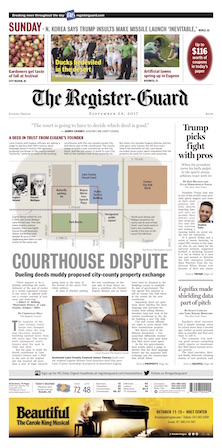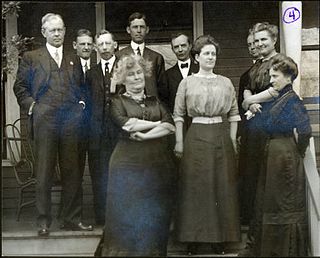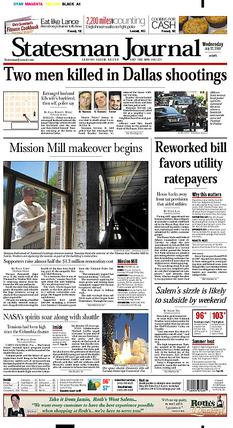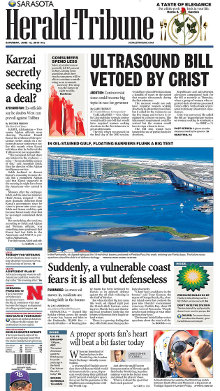
Allen Harold "Al" Neuharth was an American businessman, author, and columnist born in Eureka, South Dakota. He was the founder of USA Today, The Freedom Forum, and its Newseum.

The Pulitzer Prize for Editorial Writing is one of the fourteen American Pulitzer Prizes that are annually awarded for Journalism. It has been awarded since 1917 for distinguished editorial writing, the test of excellence being clearness of style, moral purpose, sound reasoning, and power to influence public opinion in what the writer conceives to be the right direction. Thus it is one of the original Pulitzers, for the program was inaugurated in 1917 with seven prizes, four of which were awarded that year. The program has also recognized opinion journalism with its Pulitzer Prize for Editorial Cartooning from 1922.

The Courier Journal, also known as the Louisville Courier Journal, and called The Courier-Journal between November 8, 1868, and October 29, 2017, is a daily newspaper published in Louisville, Kentucky and owned by Gannett, which bills it as "Part of the USA Today Network".
During the 2004 United States presidential election, the online edition of Editor & Publisher, a journal covering the North American newspaper industry, tabulated newspaper endorsements for the two major candidates, Republican incumbent George W. Bush and Democratic challenger John Kerry. As of November 1, 2004, their tally shows the following:

The Pulitzer Prizes for 1980 were announced on April 14, 1980. A total of 1,550 entries were submitted for prizes in 19 categories of journalism and the arts. Finalists were chosen by expert juries in each category, and winners were then chosen by the 16-member Pulitzer Prize Board, presided over by Clayton Kirkpatrick. For the first time in the Prizes' history, juries were asked to name at least three finalists in each category, and the finalists were announced in addition to the winners. Each prize carried a $1,000 award, except for the Public Service prize, which came with a gold medal.

The Register-Guard is a daily newspaper in the northwestern United States, published in Eugene, Oregon. It was formed in a 1930 merger of two Eugene papers, the Eugene Daily Guard and the Morning Register. The paper serves the Eugene-Springfield area, as well as the Oregon Coast, Umpqua River valley, and surrounding areas. As of 2019, it had a supposed circulation of 18,886 daily.
The Newspaper Preservation Act of 1970 was an Act of the United States Congress, signed by President Richard Nixon, authorizing the formation of joint operating agreements among competing newspaper operations within the same media market area. It exempted newspapers from certain provisions of antitrust laws. Its drafters argued that this would allow the survival of multiple daily newspapers in a given urban market where circulation was declining. This exemption stemmed from the observation that the alternative is usually for at least one of the newspapers, generally the one published in the evening, to cease operations altogether.

Casper Salathiel Yost (1864–1941) was the longtime editor of the St. Louis Globe-Democrat, a poet and an honored journalist.

The Statesman Journal is the major daily newspaper published in Salem, Oregon, United States. Founded in 1851 as the Oregon Statesman, it later merged with the Capital Journal to form the current newspaper, the second-oldest in Oregon. The Statesman Journal is distributed in Salem, Keizer, and portions of the mid-Willamette Valley. The average weekday circulation was 27,859, with Sunday's readership listed at 36,323, in 2012.. It is owned, along with the neighboring Stayton Mail and Silverton Appeal Tribune, by the national Gannett Company.

The Sarasota Herald-Tribune is a daily newspaper, located in Sarasota, Florida, founded in 1925 as the Sarasota Herald.
The National Association of Black Journalists (NABJ) is a 501(c)3 nonprofit educational and professional organization of African-American journalists, students, and media professionals. Founded in 1975 in Washington, D.C., by 44 journalists, the NABJ's stated purpose is to provide quality programs and services to and advocate on behalf of black journalists. The organization has worked for diversity and to increase the number of minorities in newsrooms across the country.
The Missouri School of Journalism housed under University of Missouri in Columbia is one of the oldest formal journalism schools in the world. The school provides academic education and practical training in all areas of journalism and strategic communication for undergraduate and graduate students across several media platforms including television and radio broadcasting, newspapers, magazines, photography, and new media. The school also supports an advertising and public relations curriculum.
The Yankee Quill Award is a regional American journalism award that recognizes a lifetime contribution toward excellence in journalism in New England. The award is bestowed annually by the Academy of New England Journalists, and administered by the New England Society of Newspaper Editors. It is considered the highest individual honor awarded by fellow journalists in the region.
The Beaverton Valley Times, also known as the Valley Times, is a weekly newspaper covering the city of Beaverton, Oregon, United States, and adjacent unincorporated areas in the northern part of the Tualatin Valley. Owned since 2000 by the Pamplin Media Group, the paper was established in 1921. Currently based in neighboring Portland, the Valley Times is printed each Thursday.
Jay T. Harris, an African-American journalist; journalism educator at the Medill School of Journalism, Northwestern University in Chicago, Illinois; and chairman and publisher of the San Jose Mercury News in San Jose, California, United States. He is a self-described "journalistic traditionalist" and stepped down as publisher as a statement about how the newspaper industry's emphasis on profits was harming its public mission. He was inducted into the Hall of Fame of the National Association of Black Journalists in 1992.
Jerome Merle Ceppos was an American journalist, news executive, and educator.
Journalism in the U.S. state of Oregon had its origins from the American settlers of the Oregon Country in the 1840s. This was decades after explorers like Robert Gray and Lewis and Clark first arrived in the region, several months before the first newspaper was issued in neighboring California, and several years before the United States formally asserted control of the region by establishing the Oregon Territory.

Sandra Mims Rowe is an American journalist. She is the former editor of The Virginian-Pilot in Norfolk, Virginia, and of The Oregonian, in Portland, Oregon. She was one of the few women editors of metro newspapers in the 1980s, and was the first woman editor at The Virginian-Pilot and The Oregonian. She was the second female president of the American Society of News Editors, a decade after Kay Fanning, the editor of The Christian Science Monitor, was the first.










